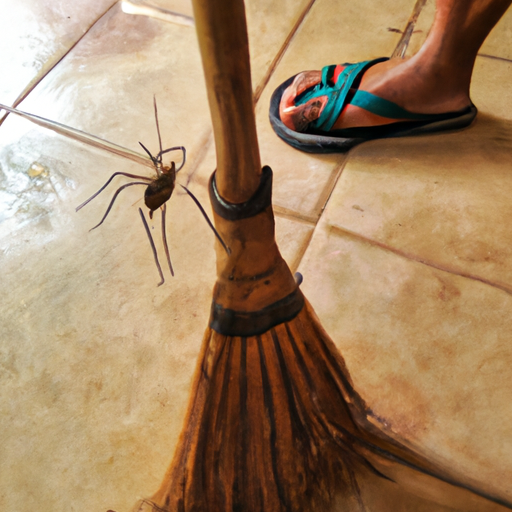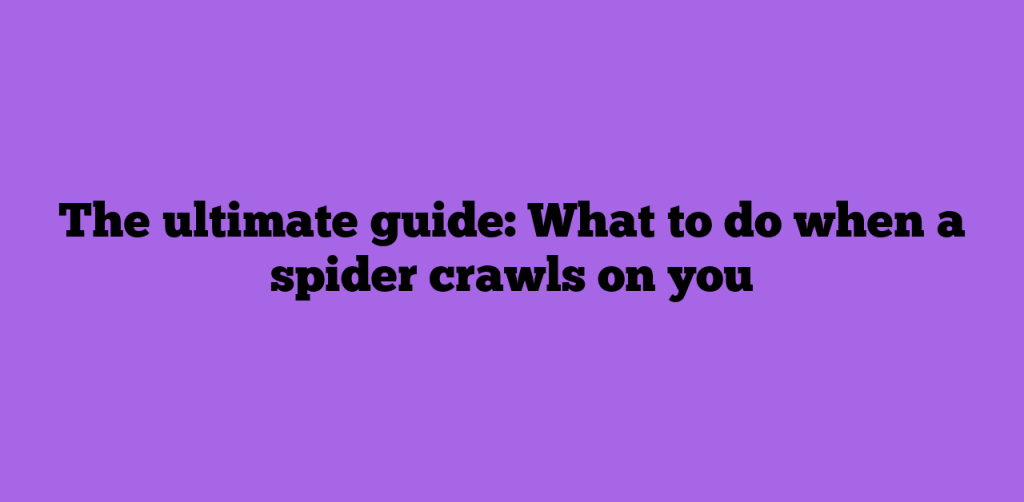
Contents
Introduction
Imagine this: you’re going about your day, and suddenly, you notice a spider crawling on you. It’s a situation that many people dread, but it’s essential to know how to react when it happens. As an expert in spiders, I’m here to provide guidance on what to do when these eight-legged creatures find their way onto your body or clothing.
In this ultimate guide, we’ll explore the importance of staying calm, assessing the situation, and safely removing the spider. Additionally, we’ll discuss when to seek medical attention if necessary and preventive measures to reduce future encounters with spiders. So let’s dive in and learn how to handle those unexpected moments when a spider crawls on you.
Stay Calm and Still
Encountering a spider crawling on you can be an unsettling experience, especially for those with arachnophobia. However, it is crucial to stay calm and still during these moments. Panicking or making sudden movements could startle the spider, increasing the chances of being bitten.
To remain calm, consider the following tips:
- Control your breathing: Taking slow, deep breaths can help soothe anxiety and prevent panic. Focus on inhaling through your nose and exhaling through your mouth.
- Acknowledge the fear: Recognizing that it’s natural to feel fear when a spider is on you can help put things in perspective. Remind yourself that most spiders are harmless and not aggressive towards humans.
- Visualize a positive outcome: Close your eyes and imagine successfully removing the spider from your body without harm to either you or the arachnid.
Once you have successfully calmed yourself, maintaining stillness is essential. Avoid swatting at the spider or making fast movements that may cause it to react defensively. By staying still and composed, you’ll be better equipped to handle the situation safely and effectively.
In the next section, we will discuss how to assess the situation by identifying the type of spider crawling on you.
Assess the Situation
When encountering a spider crawling on you, it’s crucial to assess the situation and identify the spider. This step is important because most spiders are harmless and not aggressive towards humans. Recognizing the type of spider can help you determine if it poses any threat and decide how to proceed.
To identify the spider, observe its size, color, markings, and other distinguishing features. Compare these characteristics with descriptions and images of common harmless spiders. Some examples of harmless spiders include:
- Cellar spiders (Pholcidae): Long-legged and pale-colored spiders that are often found in dark corners of homes.
- Orb-weaver spiders (Araneidae): These spiders construct large, circular webs and have distinctive rounded abdomens.
- Jumping spiders (Salticidae): Small, hairy spiders with excellent vision and a tendency to jump when disturbed.
- Wolf spiders (Lycosidae): Ground-dwelling hunters with robust bodies and a characteristic eye arrangement.
Note: It’s essential to mention that some regions may have venomous or dangerous spiders. If you live in an area where this is a concern, familiarize yourself with local species for better identification.
By carefully assessing the situation and identifying the spider crawling on you, you can determine whether it poses any risk. In most cases, you will find that the spider is harmless and can be safely removed without causing harm to yourself or the arachnid. In the next section, we will discuss methods for safely removing a spider from your body or clothing.
Identifying Harmless Spiders
To better understand and identify the type of spider crawling on you, it’s helpful to familiarize yourself with some common harmless spiders. Below is a list of frequently encountered non-dangerous spiders:
- Cellar Spiders: These spiders have long, thin legs and are often found in basements or cellars. They are sometimes called “daddy long-legs” but should not be confused with harvestmen, which are not true spiders.
- Jumping Spiders: Small, furry, and often brightly colored, jumping spiders can leap impressive distances but pose no threat to humans.
- Orb Weaver Spiders: Recognizable by their large, intricate webs, orb weavers come in various shapes and sizes but are generally harmless.
- Grass Spiders: With their elongated bodies and prominent spinnerets, grass spiders create funnel-shaped webs in grassy areas and are not dangerous to humans.
- House Spiders: The common house spider is typically brown or gray with a patterned abdomen. They prefer dark corners indoors but pose no risk to people.
By recognizing these harmless species, you can feel more at ease when encountering a spider in your daily life. Remember that most spiders are not aggressive and will only bite if they feel threatened.
Remove the Spider Safely
Once you’ve assessed the situation and determined that the spider is harmless, it’s crucial to safely remove the spider from your body or clothing. Here are some steps to follow:
- Stay calm and avoid sudden movements: Panicking or making quick moves may cause the spider to bite in self-defense. Maintain your composure and move slowly.
- Use a gentle brush or object: Find an item with a soft bristle, such as a paintbrush or makeup brush, to coax the spider onto it. If a brush is not available, you can use a piece of paper or cardboard.
Tip: Approach the spider from the side rather than directly from above, as this may startle it.
- Encourage the spider to crawl onto the object: Gently touch the spider’s rear legs with your chosen tool, nudging it to move forward and crawl onto the brush or paper.
- Transport the spider outdoors: Once the spider is on your object of choice, carefully carry it outside and allow it to crawl off into its natural habitat.
- Keep a safe distance: While releasing the spider, ensure you maintain a safe distance between yourself and the arachnid to prevent it from crawling back onto you.
It’s essential to emphasize that we must respect and protect these creatures, as they play a critical role in our ecosystem by controlling insect populations. Avoid squishing or harming the spider while attempting to remove it.
Seek Medical Attention (If Necessary)
Most spider bites are harmless and don’t require medical attention. However, it’s essential to be aware of the symptoms of dangerous spider bites to act accordingly if necessary.
Common Symptoms of Dangerous Spider Bites
- Intense pain at the bite site
- Swelling and redness around the bite
- Muscle cramps or spasms
- Chills or fever
- Difficulty breathing
If you experience any of these severe symptoms, it’s crucial to seek medical help immediately.
What to Do If You Suspect a Dangerous Spider Bite
- Wash the bite area with soap and water to reduce the risk of infection.
- Apply a cold pack or ice wrapped in a cloth to the bite site to help reduce pain and swelling.
- Elevate the affected area, if possible, to help minimize swelling.
- Take over-the-counter pain relievers such as acetaminophen or ibuprofen for pain relief, if necessary.
Remember that not all spider bites lead to severe symptoms, but it’s always better to be cautious and seek professional advice in case of uncertainty.
In the next section, we will discuss preventive measures that can help you avoid spider encounters altogether.
Preventive Measures
Reducing the chances of spider encounters is essential, as it not only decreases the likelihood of experiencing a crawling spider on you but also minimizes any potential risks associated with spider bites. Here are some preventive measures and tips to follow:
- Keep your surroundings clean and clutter-free: Spiders often seek shelter in piles of clutter, such as old newspapers, boxes, or clothes. Regularly tidying up and maintaining a clean living space can deter spiders from finding hiding spots.
- Seal cracks and crevices: To prevent spiders from entering your home, ensure that all gaps around windows, doors, and walls are sealed.
- Regularly dust and vacuum: Dusting and vacuuming around corners, ceilings, and less frequently used areas can help remove webs and discourage spiders from nesting.
- Use natural repellents: Some natural substances, such as peppermint oil or vinegar, can repel spiders. Spraying these in key areas may help keep them at bay.
By implementing these preventive measures, the likelihood of encountering spiders crawling on you can be significantly reduced.
Conclusion
- Stay Calm and Still: Avoid startling the spider by remaining calm and controlling your breathing.
- Assess the Situation: Identify the type of spider, as most are harmless and not aggressive towards humans.
- Remove the Spider Safely: Gently encourage the spider onto a brush or object, avoiding harm to both parties.
- Seek Medical Attention (If Necessary): Most spider bites are harmless, but seek help if experiencing severe symptoms.
The importance of staying calm and assessing the situation cannot be overstated. Remember that most spiders pose no threat to humans, and reacting appropriately can prevent unnecessary harm. For further information on spiders and their behavior, consult reputable sources such as The American Arachnological Society or The British Arachnological Society.
